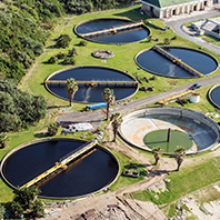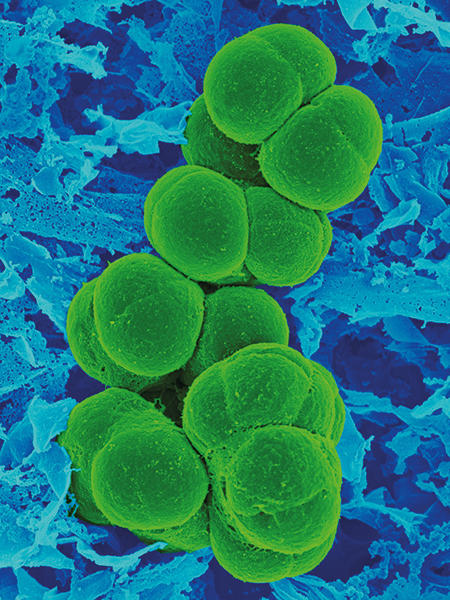Archaea in activated sludge systems
Issue: Archaea
08 August 2017 article

Biological wastewater treatment plants were originally used mainly for removing organic matter and suspended soils, but later advances increased their goals to eliminate toxic metals, odours, nutrients and pathogens.
The activated sludge process (ASP) is the preferred choice in biological wastewater treatment plants, providing a major contribution to environmental protection. This process was developed in England in 1914 and owes its name to the production of activated microbial mass capable of aerobically stabilising the organic content of wastewater. It is the most versatile biological treatment process, and is able to produce high-quality effluents at reasonable costs, although it can be responsible for the release of greenhouse gases.
How does the ASP work?
In the ASP, several micro-organisms feed on organic contaminants present in wastewater. They cluster together and gradually build up to larger solids, forming the activated sludge (AS, and also known as floc). Flocs are allowed to settle to the bottom of tanks, leaving a relatively clear wastewater free of organic material and suspended solids.
Flocs must be kept in suspension during contact with the wastewater being treated, and a small percentage of AS is recirculated into the aeration tank, where it is mixed with the primary effluent. This recirculation is vital, as the recycled microbes are already well acclimated and readily metabolise organic material in the primary effluent.
The ASP mode of operation and structure can vary, but the balance of organisms present in the AS will indicate the overall health and ability of the activated system.
Microbial constitution of AS
Bacteria constitute a major percentage of the biological composition present in AS and play a key role in structural and functional activity of flocs. The predominant type of bacteria is determined by the nature of the organic substances in wastewater, mode of operation of the plant and the environmental conditions.
Archaea in AS
Most studies focusing on the microbiology of AS have centred on bacteria, while archaea have been largely neglected. Molecular-based investigations consistently detect members of the Archaea in AS, consisting of methanogens and putative ammonia-oxidising archaea (AOA) and belonging, respectively, to the phyla Euryarchaeota and Thaumarchaeota. Despite wide divergence in values, archaea seem to constitute a small fraction of the total microbial community, and play minor roles in nitrogen- and carbon-removal. Indeed, previous studies point to a range from 0 to 10% of the total microbiota, although several have likely underestimated their numbers.

Ammonia oxidisers
AOA have been alternatively reported as completely absent, providing a minimal or equal contribution to their bacterial counterparts (AOB), or even as dominant. Relative dominance seems to be linked mostly to ammonia concentration, with AOA being able to grow under ammonia-limiting concentrations. Other factors that condition AOA abundance are their higher sensitivity to drought, lysis, temperature and changes in pH.
The activity of AOA is still controversial, with disagreement between authors, and there are some suggestions that the detected archaeal amoA (the marker gene for ammonium oxidation) might be present in archaea that encode the gene but are not actively oxidising ammonia.
When detected, archaeal-based removal of nitrogen involves the phylum Thaumarchaeota. Previous environmental studies have highlighted their significant role in the biogeochemical cycle of nitrogen (and carbon), placing them as the main ammonia-oxidisers in, for example, oceans and geothermal habitats. Given that ammonia is the main nitrogen species in urban wastewaters, their relatively low numbers in AS are unexpected.
Methanogens
Methanogens are the most abundant archaea in AS, and are generally represented by species of Methanosarcinales, Methanobacteriales and Methanomicrobiales. Typical abundant genera include Methanosaeta and Methanosarcina.
The high O2 content of AS makes it a less than welcoming environment for methanogens as they are known to be strictly anaerobic. Methanomicrobiales and Methanobacteriales form methane by CO2 reduction, with H2, formate or alcohols as electron donors. Some members of the latter group can also oxidise CO or reduce methanol (instead of CO2). Members of the Methanosarcinales traditionally grow by dismutation of methyl compounds (methanol, methyl amines or methyl sulfides) or by splitting acetate (acetoclastic). Some can also form methane by reduction of CO2 or methyl compounds, by using H2 as an electron donor. Methanogens form therefore a highly specialised physiological group, unable to catabolise carbohydrates, proteins or organic compounds other than methanol, some secondary alcohols, formate or CO.
These higher loads of methanogens can be a reflection of the composition of the original wastewater. Methanobacterium, Methanosaeta and Methanosarcina are the prevalent archaeal genera in diverse types of industrial wastewaters (such as in breweries, wineries or dairies). Also, many methanogens likely enter the sludge with a stream of recycled water from an anaerobic reactor. The anaerobic conditions in the reactor would allow them to thrive and develop much better.
Aerated conditions of AS do not fully exclude methanogens, however. Anoxic micro-environments can exist in deeper parts of the flocs where oxygen won’t reach. Furthermore, several methanogens are now known not to be as sensitive to oxygen as originally estimated. Indeed, several reports show that they can maintain viability and activity even in the presence of high levels of oxygen. Fittingly, studies targeting metabolically active archaea in AS detected methanogens, with highest numbers within the orders Methanonomicrobiales and Methanosarcinales and in the genera Methanocella and Methanosarcina.
Despite the aforementioned evidence for a limited role and diversity of archaea in AS, some studies suggest that they might have other functions or affect the properties of AS (such as contributing to floc structure or being in symbiotic relationship with bacteria). Their contribution to floc structure is particularly important as poor flocculation and settling of AS leads to reduced effluent quality and can cause severe environmental issues.

Conclusions
Recent advances in molecular-based methodologies have significantly increased our knowledge on the phylogenetic and functional diversity of wastewater treatment systems. Most of the information is still derived from the most abundant members of the community (i.e. bacteria). We now know that archaea constitute a minor but constant and integral part of activated sludge. Differences can be observed depending on the wastewater treatment plant, mode of operation of the treatment process, time of the year, physical and chemical characteristics of the AS, or even on the methodologies used for analysis.
Even with their apparently less pronounced role and abundance, they have been linked to important functions in AS, and seem to condition the overall efficiency and quality of the process. Additional studies, preferably using polyphasic and complementing technologies, are necessary to fully understand their community’s diversity, distribution and functionality in these environments.
Marta Filipa Simões & André Antunes
Biology Department, Edge Hill University, Ormskirk L39 4QP
[email protected]
[email protected]
Further reading
Calderón, K. & others (2013). Archaeal diversity in biofilm technologies applied to treat urban and industrial wastewater: recent advances and future prospects. Int J Mol Sci 14, 18572–18598.
Ferrera, I. & Sánchez, O. (2016). Insights into microbial diversity in wastewater treatment systems: How far have we come? Biotechnol Adv 34, 790–802.
Fredriksson, N. J. & others (2012). Diversity and dynamics of Archaea in an activated sludge wastewater treatment plant. BMC Microbiol 12, 140.
Guo, J. & others (2017). Unraveling microbial structure and diversity of activated sludge in a fullscale simultaneous nitrogen and phosphorus removal plant using metagenomic sequencing. Enzyme Microb Technol 102, 16–25.
Park, H. D. & others (2006). Occurrence of ammonia-oxidizing Archaea in wastewater treatment plant bioreactors. Appl Environ Microbiol 72, 5643–5647.
Images: Aerial view of a sewage treatment plant. Peter Chadwick/Scienec Photo Library. Coloured scanning electron micrograph of Methanosarcina barkeri. Dennis Kunkel Microscopy/Science Photo Library. Coloured scanning electron micrograph of Methanosarcina mazei. Eye of Science/Science Photo Library.
